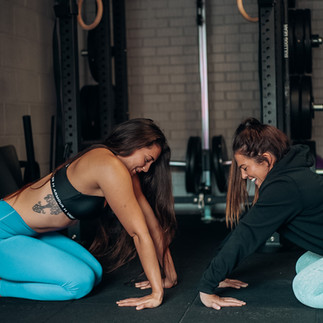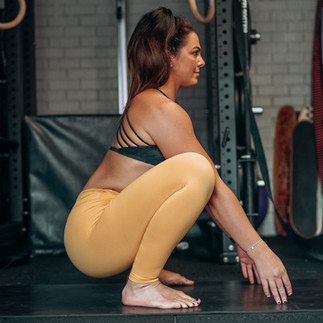Why prioritise your mobility?..PART 3
- Georgina Gabriel

- Jul 20, 2022
- 4 min read
Just like you wouldn't stop brushing your teeth and expecting them to stay clean, you can't stop prioritising your joint health and expecting to have range of motion when ever you need and want it there.
My MVMT Library offers you the ability to work on your flexibility whether you have 5 minutes or 60 minutes spare. There are lots of flows to help you move better from full body flows or specific body part flows. The key to success is to be consistent each week. Check it out for 7 days free below!..
Tip #3 - Why prioritise?..
Life is pretty full on, you're busy with work, family life and always rushing to get through your to do list, maybe you just about manage to squeeze the gym in, or maybe you don't. Ask yourself a really important question though...How much do you actually move each day?
Make a note of what you do day to day and have a think about how many of those movements are linear? Maybe walking, running, picking something up and putting it down again, being sat in one position for hours hunched over? Sound familiar?
How much do your rotate, bend or extend your body?
Do you ever struggle with joint pain, struggle to recover from training, maybe you are fed up of hitting plateaus or constantly feeling tight?
'Our bodies are designed to move, don't let yourself become stuck. We need to explore.'
Not doing your mobility work is going to show up at some point, whether thats an injury, feeling tight and sore all the time, not being able to do day to day functional tasks, or perhaps feeling unable to advance your current skill level in the gym. I see mobility work as a tool allowing me to do what I love for longer.
By looking after your joints and working on your flexibility you will actually get stronger! You will be able to access tissue more easily to be able to move through a wider range of motion.
Here are some examples of why better flexibility means more efficiency in the gym...
'By improving the range of motion in my squat and squatting ass to grass, I now have a stronger, safer and improved catch position in my squat clean and snatch.'
'By improving the range of motion in my spine, hips and hamstrings, I can hinge better and pull more off the floor in my deadlift.'
'By improving the range of motion in my scapular, I have better awareness, strength and control to perform muscle ups, dips, pull ups and handstands.'
These are just some examples of how working through full range of motion and improving flexibility can impact the gym, but there are many more.
When it comes to everyday life it might be that you feel less discomfort or tightness when you wake up, you can get in and out of a chair or the car more easily, you don't feel pain in your knees going up and down the stairs, you can reach that top cupboard in the kitchen, and you can pick up that awkward object without throwing your back out.
Waiting to be ready to make time for your flexibility so you can move better and feel better is like joining a gym membership, but never showing up and not understanding why you still aren't fitter than when you joined. Better flexibility = increased movement potential.
Prioritise moving better and counteracting the poor habitual patterns we get stuck in day to day, because life in general, not just training will become easier mentally and physically.
Here are some examples that will improve your quality of life if you start now...
Morning movement 5-10 minutes, something dynamic rather than holding stretches which can tend to make your feel more tired.
Dynamic flexibility warm ups prior to a dynamic training session. Dynamic flexibility work improves dynamic flexibility just as static flexibility work improves static flexibility....Kind of obvious. Make it relative to your sport/training session.
Train through a full range of motion in the gym. No bro reps here! Squat full depth, and if you can't then use a platform so that you can such as a heel elevation to strengthen a deeper range. Do your pull ups from arms extended until you get your chest all the way to the bar as high as you possibly can. Elevate your self on P-bars for your push ups to train deep shoulder extension...These are just some examples, so have a think about how this might apply to your training.
Desk breaks from work even if you only do a movement for a minute, doing this consistently adds up. Pick a movement such as a reverse table top reach or a full squat, or a deep lunge...What ever it is pick one and then the next break, pick another
Post training stretching to increase blood flow, aid in recovery and leave you feeling more mentally relaxed too.
None of these movement sessions need to be long. You are better doing little and often rather than trying to schedule in an hour that then doesn't happen.
For more help in your movement and mobility check out how I can help you below:



























شيخ روحاني
جلب الحبيب
الحصول على باك لينك قوى لموقعك من خلال تبادل اعلانى نصى
معنا عبر004917637777797 الواتس اب
شيخ روحاني
جلب الحبيب
Berlinintim
Berlin Intim
https://www.eljnoub.com/
https://hurenberlin.com/
سكس العرب
شيخ روحاني لجلب الحبيب
شيخ روحاني
رقم شيخ روحاني
رقم شيخ روحاني
شيخ روحاني في برلين
رقم شيخ روحاني 00491634511222
الشيخ الروحاني
شيخ روحاني سعودي
شيخ روحاني لجلب الحبيب
Berlinintim
bestbacklinks
backlinkservices
buybacklink
Berlinintim
Escort Berlin
شيخ روحاني
معالج روحاني
الشيخ الروحاني
الشيخ الروحاني
جلب الحبيب العنيد
جلب الحبيب بسرعة
شيخ روحاني الاردن
شيخ روحاني عماني
شيخ روحاني سعودي
شيخ روحاني مضمون
شيخ روحاني مضمون
معالج روحاني سعودي
شيخ روحاني مغربي
شيخ روحاني في قطر
شيخ روحاني لجلب الحبيب
شيخ روحاتي في السعودية
شيخ روحاني في البحرين
شيخ روحاني في…
A trusted compound in the world of enhancement, athletes and bodybuilders turn to nandrolone decanoate for its reputation in promoting lean muscle mass, strength, and recovery. With a balanced release profile, it supports consistent performance and endurance while aiding joint health. Carefully managed use makes it a valuable choice for those seeking reliable, steady progress.
Visual storytelling creates unforgettable passion. At the heart, antarvasna sex video showcases raw emotions, romantic intensity, and hidden desires in action. These videos provide a direct, immersive way for individuals to experience fantasies, blending visual appeal with emotional depth.
Poona Mehra provides a luxurious call girl service that accepts cash payments, so if you are searching for a call girl nearby, your search ends here. On lonely evenings, our general selection of stunning Call Girls is the ideal companion for everyone. Contact us by phone or send a WhatsApp message to the provided phone number if you want to book a girl. We offer doorstep delivery to your house or hotel room 24/7.
Call Girl Amritsar
Call Girl Andheri
Call Girl Bhopal
Call Girl Thane
Call Girl Mira Road
Call Girl Wakad
Call Girl Hinjewadi
Call Girl Koregaon Park
Call Girl Viman Nagar
Call Girl Dwarka
Experience intimate pleasures and adult entertainment with redwap sex video, offering exclusive categories and bold stories. Perfect for viewers who want passionate content at their fingertips. Enjoy smooth streaming, high-definition quality, and endless variety while ensuring private, safe, and enjoyable entertainment whenever desire strikes, creating unforgettable satisfaction online.